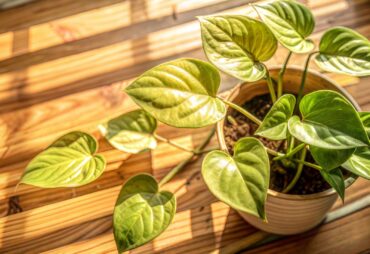
House plants are a great way to bring the outdoors into the comfort and warmth of your home through all seasons. In addition to being aesthetically pleasing, this beautiful range of plants often comes with a number of benefits to our physical and mental health, including reduced stress and anxiety, better sleep quality and even respiratory benefits.
Houseplants are natural air purifiers that can help to rid your home of pollutants such as carbon dioxide that build up to unhealthy levels over time. Here are some of the top plants for purifying the air in your home and improving your overall wellbeing.
Rubber Plant
Ficus elastica, more commonly known as the rubber plant, is a species of flowering plant native to eastern parts of South and Southeast Asia. These plants are hardy but prefer to be kept in dim light and cooler temperatures, making them ideal as houseplants.
In addition to serving as a beautiful accent piece within a room, rubber plants can remove airborne toxins and fight tropical diseases and parasites. They are particularly effective at removing formaldehyde from the air, which is found in cleaning supplies and furniture.
Care tips:
- Wipe the leaves with a moist paper towel every now and then to keep their pores open for optimal air purification.
- Place in a spot with bright, indirect sunlight, avoiding direct afternoon sunlight, which can scorch the leaves.
- Rubber plants prefer high humidity, so moist of the leaves regularly or place the pot on a tray of wet pebbles.
English Ivy
The English ivy, also referred to as common ivy, is a species of flowering plant native to most of Europe and parts of Western Asia. It is a highly adaptable houseplant that can thrive in a variety of conditions, making it a very popular choice for interior décor.
This easy-to-care-for vine can help reduce mold in the home and offer stunning visual appeal. It is worth noting, however, that ivy can be toxic for cats and dogs, so it may be best suited to a pet-free environment.
Care tips:
- Ivys prefer bright, indirect light and it’s best to keep them out of direct sunlight.
- Keep soil moist and water thoroughly when the top inch feels dry, but do not let your plant sit in water.
- Keep temperatures cool to moderate and consider increasing humidity through misting or other methods.
Peace Lily
Peace lilies are evergreen perennial plants native to tropical regions of the Americas and Southeast Asia. They make for a beautiful indoor decorative houseplant for both beginners and plant experts.
Not only are they a stunning accent feature for any home, but studies show that they can filter formaldehyde, ammonia and other harmful toxins that can cause headaches and respiratory problems from indoor air. They can also remove airborne mold that aggravates allergies and asthma symptoms.
Care tips:
- Keep the plant in a room with average temperature, avoiding cold draughts.
- Feed with a diluted liquid houseplant fertilizer every few weeks during the spring and summer months.
- Water when the top inch of the soil feels dry, allowing it to mostly dry out between watering.
Spider Plant
Chloropythum comosum is more commonly known as the spider plant due to its spider-like look. They are a species of evergreen perennials native to tropical and Southern Africa but have become naturalized in other parts of the world, such as Western Australia and Bangladesh.
This is one of the easiest houseplants to grow and is natural at absorbing carbon monoxide and formaldehyde while decomposing benzene and nicotine. Just one plant in an average-sized living room is enough to be an effective air filter.
Care tips:
- Ensure that the pot has good drainage to prevent soggy soil and root rot.
- Room temperature is the perfect growing environment for a spider plant, and it’s best to avoid extreme fluctuations.
- While they appreciate some humidity, spider plants can easily adapt to indoor conditions.
Snake Plant
The snake plant is a species of flowering plant native to tropical West Africa. This plant is often kept as a houseplant as it is very low-maintenance and can survive with very little water and sunlight. The leaves can also be boiled to make a holistic medicine to apply to the skin to treat pain and irritation.
Snake plants can remove a wide range of pollutants from the air within a home, including benzene, formaldehyde and xylene. Therefore, as well as making a delightful statement floor piece, they are useful in reducing the effects of allergies and respiratory conditions.
Care tips:
- These plants prefer bright indirect light but can also tolerate low-light conditions.
- Wipe leaves with a damp cloth occasionally to remove any dust that may have accumulated.
- Feed with diluted liquid fertilizers once a month during the spring and summer seasons.
Pothos
Pothos is a genus of flowering plants native to China, the Indian Subcontinent and Australia, among other regions. This species is arguably the easiest houseplant to care for, and this makes it a popular choice, along with its many varieties and beautiful heart-shaped leaves.
These plants are one of the best for removing all types of indoor toxins, so they provide a range of health benefits as well as aesthetic and practical ones. They tolerate lower light, humidity and temperature, so they can be incorporated into almost any home environment.
Care tips:
- Water more often in brighter light and less often in lower light, around every one to two weeks on average.
- Place in a bright, indirect light, such as on an east- or west-facing windowsill.
- Pothos plants are good for propagation, and you can grow more by taking cuttings from the vines.
Final Thoughts
When trying to improve our physical and mental health, we often consider many options, such as exercise, diet and meditation. The common houseplant is often neglected in our thought process aside from in terms of visual appeal, but it can purify the air in your home, leading to a healthier and happier you.




























